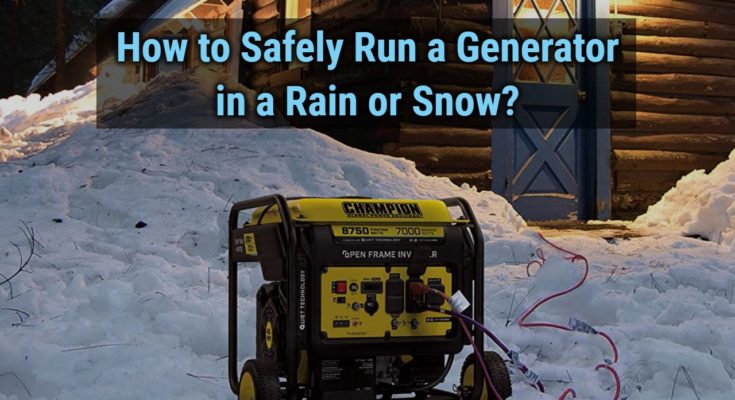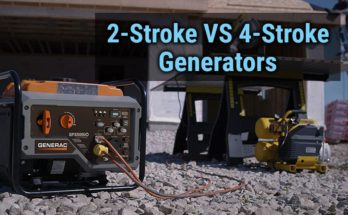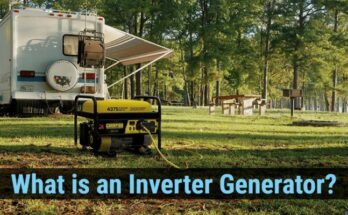A generator is an important piece of equipment to have in the house if you experience frequent power outages. It not only powers appliances but can also be used for recreational uses like backyard parties, camping, and tailgating.
It keeps the essentials of the house running during natural disasters like hurricanes, storms, and heavy rainfall. Most people can ride through power outages without the power, but some need electric power in an instant after the grid power vanishes.
But there is a problem during rainfall; you can’t run a generator inside. You will have to put it outside in the rain, and the generator can’t be exposed to rain. So, is there still a way to run a generator during the rain while also eliminating all these problems? That’s what we will discuss in this post. So how will it be done? Let’s see.
Table of Contents
Water is Not Good for A Generator
The main function of the generator is to produce electricity, electricity which can flow through the water and electrocute someone who is in contact with that water.
It not only risks generator damage due to internal short circuits but also exposes you and your family members to electrical shocks. So, to avoid this, you’ll need to protect your generator from the rain and so from snow and any type of moisture.
Moreover, if water goes into an electrical outlet, the situation becomes even more dangerous. Suppose your generator has GFCI protection. So, they will stop the power flow to the outlets, but that isn’t good.
Now, if someone goes to inspect what happened, why there isn’t a power, then the person might experience a heavy shock. Resetting of GFCI outlets will also lead to a shock.
Other than that, if water enters into the engine through an air inlet, then the mixture of water and fuel won’t burn, and the generator will fail to operate; it won’t run. It is important to note that an air filter in an air inlet is to prevent the small particles in the air and not the water, so water will pass right through it.
From where it will get inside the engine?
The air inlet is not the only way to get inside the engine. In some cases, the water can get in through an exhaust pipe. From there, the water will get inside and get mixed with the fuel and water. Again the engine won’t run.
Also, water may deteriorate the spark plug. Water on the spark plug interferes with its working, and there won’t be any spark to ignite the fuel and air mixture. The generator will fail to start, and you will need to replace the spark plug if it gets damaged.
So, from the discussion, we can conclude that the water is not good for a generator.
How to Use a Generator in Rain?
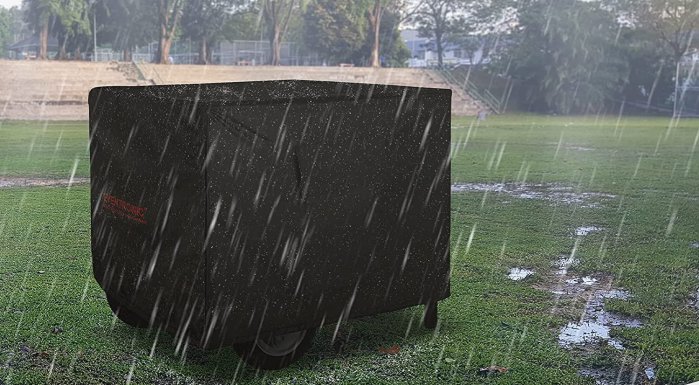
Sometimes, you may need to run the generator during rain, and it might be necessary even if you don’t want to. So how can you do it safely, obviously you can’t just put the generator outside and start it when the water is pouring down from the sky. A generator can run during rain, but you will have to take some safety measures to prevent the water from getting inside the generator.
The simple and most effective solution is to use a protective cover; it can prevent the water from getting inside; this will ensure that the generator keeps functioning without any hindrance. So, there will be no problems due to water now. There are many types of protective covers in the market, and they are specially designed to protect the generator from rain.
Another thing you can do is to build a protective shed for it yourself, and it can be of bricks or wood. Also, keep in mind when building such a shelter that a generator will need enough airflow when it is running. Airflow is for cooling purposes and to prevent fumes build up. So, provisions for that should be made.
If you don’t want to build a shelter, then you can use a portable and foldable small tent that can prevent the rainwater from getting inside. Also, it has the added advantage of being portable, and you can bring it with you wherever you like. They are also designed for generator use and will have proper ventilation facilities.
Moreover, you can purchase a metal enclosure. This is not a very convenient option as they are not much portable without wheels.
Protecting Your Generator from Rain and Snow
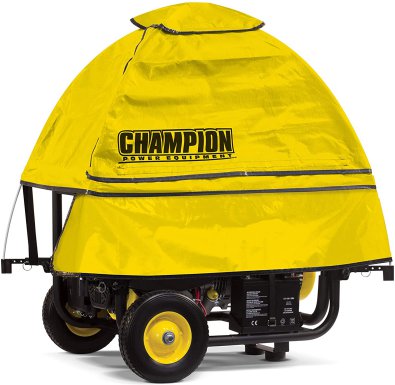
As mentioned, to protect the generator from rain or snow, you will need some kind of enclosure or cover. So, which types of covers and enclosures are in the market which you can purchase.
Pop-Up Canopies
Pop-up canopies are simply tarps with an extended panel that will cover the sides of the generator. It will efficiently protect the generator’s internal components and power outlets. There are various types of pop-up canopies available in the market, and you can purchase the one which suits your needs.
It can protect the generator from rain, but its capability is limited to moderate rain. For heavy rainfall with winds that have a velocity of more than 20 mph, they aren’t enough. Additionally, it won’t be able to protect the power outlets when the rain comes from the sides.
When you cover the generator with only a waterproof cover, heat from the engine and exhaust pipe can damage it. So, to prevent that from happening, pop-up canopies will have a frame that will keep them at a distance from the outer surface. Moreover, it is not easy to anchor them, especially in driveways.
Steel Enclosure
A steel enclosure will protect your generator from any type of rain, whether it is drizzle or heavy rainfall accompanied by high-velocity winds. This is the best option out there, but it won’t be as portable as the canopies or tents. This enclosure will be specially made for use in rain and snow, so it will have proper ventilation provisions.
In steel enclosures, the major problem will be overheating, but steel is fire-resistant, so unlike wood enclosures, they can handle the heat. For cooling purposes, you can keep the ventilation opening fully open. Other than that, when you purchase a steel enclosure, you should buy the one which is of proper size and can accommodate the generator you have. It should be installed by a professional.
Plastic Shed
A plastic shed is also a good option. It is the most economical option. Plastic sheds can do the job quite satisfactorily. One thing you will need to keep in mind when purchasing a plastic shed is to buy a larger one. There must be enough clearance between the generator and the shed. This is because a heat build-up can melt the plastic. Also, there should be proper ventilation available for the airflow.
Wooden Enclosure
You might not find any wood enclosures in the market because they are flammable, and there is always the possibility of them catching fire. But Still, it is a popular choice to be used for the enclosure. With a wood enclosure, you will have to pay special attention to the ventilation as you can’t allow the heat build-up. Other than that, you will have to design and build it yourself. So be ready for some DIY work.
DIY Enclosure
The DIY enclosure is the best choice when you don’t move your generator around much and always use it at the same place. If that is the case, then you can build a permanent shed to keep the generator in it during the rain or snow. It has many benefits. You can also use it as storage for your generator.
Take Safety Precautions when Using a Generator in a Rain
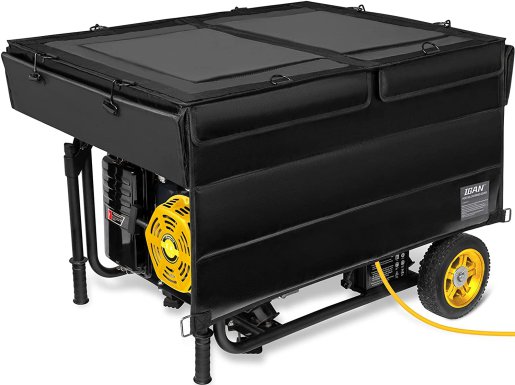
When you place the generator out in the rain, you will need to make sure that it doesn’t get submerged in the water. And also, the connection cords stay out of the puddles. The solution is to keep the generator above the ground level, on some kind of elevated support. And as far as the cords are concerned, make sure that they are rated to be used outdoors and free from any kind of cuts and damage.
A generator should be protected from the rain and to do that people use sheds or generator covers. When you are finished setting up the enclosure for a generator, you will need to make sure that it is secure, that it won’t blow off when the heavy wind blows. There is no point in having a shed if it isn’t secure.
The generator’s control panel and power outlets should be properly protected from the rain. And also, it should have good ventilation.
Other than that, when everything is ready, and the only thing that needs to be done is starting a generator, then you should ensure that you don’t do it with a wet hand in a hurry. Dry your hands and wear insulating gloves to protect yourself from a shock.
Moreover, you will need to be extra careful when you have a metal enclosure. You should inspect the cables to ensure that there is no leakage as it can make the enclosure conductive and can give a fatal shock to whoever touches it.
Why Do You Need to Protect the Generator from The Snow as Well?
Yes, it is equally important to protect the generator from the snow as well. Because when the snow falls on the generator, it accumulates, which will be converted into the water due to the high temperature of the housing. This is because the generator runs hot. Now the snow is water, it can damage the electronics component of the generator and can create many other problems.
Moreover, if you plan to place your generator on the icy ground, then don’t because the snow below the unit will melt, and you will find the unit in a puddle of mudd. So, you should keep the generator on some solid support.
When You Should Avoid Using a Generator Outside?
During a hurricane or when there is a heavy wind blowing outside, you will have to do without power during these conditions.
This is because, in a hurricane, the wind speed will reach dangerous levels. It becomes destructive, and they can blow over anything which might come in its path. If you place the generator outside in this heavy wind, then you should start exploring a new generator option.
Because there is a high possibility of heavy damage to the unit as these winds can sweep off your generator and crash it into anything in its path, like with a house or an electricity pole. So, a safe course of action is to wait till the winds slow down. You won’t have to wait much as hurricanes and tornadoes don’t persist for long durations.
Conclusion
During bad weather, a power cut is unavoidable. So, to maintain the continuity of electrical supply, most people will use a generator, which you can’t use inside the house, apparently due to the toxic exhaust. So, you need to put it outside, but what if due to heavy rain that is also not possible.
So, to tackle this kind of situation, you will need to be prepared beforehand. You can build an enclosure to keep the generator safe from the rain, or you can simply buy one from the market.
When you put your generator outside during rain, you will need to be careful. And follow all the safety tips we have mentioned in this post because safety comes first when you are working with something which has the potential to be dangerous.
Related Articles:
Can You Run a Portable Generator Overnight?
How to Properly Drain the Gas from a Generator?
Generator Won’t Start: What to Do? | Maintenance Tips & Checklist
How to Clean a Generator Carburetor?

